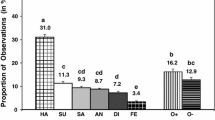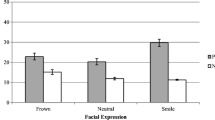Abstract
This study investigated whether sensitivity to and evaluation of facial expressions varied with repeated exposure to non-prototypical facial expressions for a short presentation time. A morphed facial expression was presented for 500 ms repeatedly, and participants were required to indicate whether each facial expression was happy or angry. We manipulated the distribution of presentations of the morphed facial expressions for each facial stimulus. Some of the individuals depicted in the facial stimuli expressed anger frequently (i.e., anger-prone individuals), while the others expressed happiness frequently (i.e., happiness-prone individuals). After being exposed to the faces of anger-prone individuals, the participants became less sensitive to those individuals’ angry faces. Further, after being exposed to the faces of happiness-prone individuals, the participants became less sensitive to those individuals’ happy faces. We also found a relative increase in the social desirability of happiness-prone individuals after exposure to the facial stimuli.




Similar content being viewed by others
References
Adolphs, R. (2002). The neurobiology of social cognition. Current Opinion in Neurobiology, 11, 231–239.
Bestelmeyer, P. E. G., Jones, B. C., DeBruine, L. M., Little, A. C., & Welling, L. L. M. (2010). Face aftereffects suggest interdependent processing of expression and sex and of expression and race. Visual Cognition, 18, 255–274.
Blair, R. J. R., & Coles, M. (2000). Expression recognition and behavioural problems in early adolescence. Cognitive Development, 15, 421–434.
Brainard, D. H. (1997). The psychophysics toolbox. Spatial Vision, 10, 433–436.
Brickman, P., Redfield, J., Harrison, A. A., & Crandall, R. (1972). Drive and predisposition as factors in the attitudinal effects of mere exposure. Journal of Experimental Social Psychology, 8, 31–44.
Bruce, V. (1994). Stability from variation: the case of face recognition. Quarterly Journal of Experimental Psychology, 47A, 5–28.
Bruce, V., & Young, A. (1986). Understanding face recognition. British Journal of Psychology, 77, 305–327.
Bruyer, R., Laterre, C., Seron, X., Feyereisen, P., Strypstein, E., Pierrard, E., et al. (1983). A case of prosopagnosia with some preserved covert remembrance of familiar faces. Brain and Cognition, 2, 257–287.
Buckingham, G., DeBruine, L.M., Little, A.C., Welling, L.L.M., Conway, C.A., Tiddeman, B.,P., & Jones, B.C. (2006). Visual adaptation to masculine and feminine faces influences generalized preferences and perceptions of trustworthiness. Evolution and Human Behavior, 27, 381–389.
Calder, A. J., & Young, A. W. (2005). Understanding the recognition of facial identity and facial expression. Nature Reviews Neuroscience, 6, 641–651.
Campbell, J., & Burke, D. (2009). Evidence that identity-dependent and identity-independent neural populations are recruited in the perception of five basic emotional facial expressions. Vision Research, 49, 1532–1540.
Carbon, C. C., Strobach, T., Langton, S. R. H., Harsányi, G., Leder, H., & Kovács, G. (2007). Adaptation effects of highly familiar faces: immediate and long lasting. Memory and Cognition, 35, 1966–1976.
Cook, R., Matei, M., & Johnston, A. (2011). Exploring expression space: adaptation to orthogonal and anti-expressions. Journal of Vision, 11, 1–9.
Crisp, R. J., Hutter, R. R. C., & Young, B. (2009). When mere exposure leads to less liking: the incremental threat effect in intergroup contexts. British Journal of Psychology, 100, 133–149.
D’Argembeau, A., Van der Linden, M., Etienne, A. M., & Comblain, C. (2003). Identity and expression memory for happy and angry faces in social anxiety. Acta Psychologica, 115, 1–15.
D’Argembeau, A., & Van der Linden, M. (2007). Facial expressions of emotion influence memory for facial identity in an automatic way. Emotion, 7, 507–515.
Eastwood, J. D., Smilek, D., & Merikle, P. M. (2003). Negative facial expression captures attention and disrupts performance. Perception and Psychophysics, 65, 352–358.
Ekman, P., & Friesen, W. V. (1976). Pictures of facial affect. Palo Alto: Consulting Psychologists Press.
Ellamil, M., Susskind, J. M., & Anderson, A. K. (2008). Examinations of identity invariance in facial expression adaptation. Cognitive, Affective, and Behavioral Neuroscience, 8, 273–281.
Engell, A. D., Todorov, A., & Haxby, J. V. (2010). Common neural mechanisms for the evaluation of facial trustworthiness and emotional expressions as revealed by behavioral adaptation. Perception, 39, 931–941.
Esteves, F., & Öhman, A. (1993). Masking the face: recognition of emotional facial expressions as a function of the parameters of backward masking. Scandinavian Journal of Psychology, 34, 1–18.
Fox, C. J., & Barton, J. J. S. (2007). What is adapted in face adaptation? The neural representations of expression in the human visual system. Brain Research, 1127, 80–89.
Frith, C. D., & Frith, U. (2007). Social cognition in humans. Current Biology, 17, R724–R732.
Gallese, R., Keysers, C., & Rizzolatti, G. (2004). A unifying view of the basis of social cognition. Trends in Cognitive Sciences, 8, 396–403.
Haxby, J. V., Hoffman, E. A., & Gobbini, M. I. (2000). The distributed human neural system for face perception. Trends in Cognitive Science, 4, 223–233.
Hsu, S. M., & Young, A. W. (2004). Adaptation effects in facial expression recognition. Visual Cognition, 11, 871–899.
Information-technology Promotion Agency, Japan (1998). Software for facial image processing system for human-like Kansei Agent [Computer software].
Jellema, T., Pecchinenda, A., Palumbo, L., & Tan, E. G. (2011). Biases in the perception and affective valence of neutral facial expressions induced by the immediate perceptual history. Visual Cognition, 19, 616–634.
Jenkins, R., White, D., Van Montfort, X., & Burton, A. M. (2011). Variability in photos of the same face. Cognition, 121, 313–323.
Jiang, F., Blanz, V., & O’Toole, A. J. (2007). The role of familiarity in three-dimensional view-transferability of face identity adaptation. Vision Research, 47, 525–531.
Johnston, R. A., & Edmonds, A. J. (2009). Familiar and unfamiliar face recognition: a review. Memory, 17, 577–596.
Kawanishi, C. (1993). The influence of face on person perception. Japanese Journal of Psychology, 64, 263–270.
Laurence, S., & Hole, G. (2011). The effect of familiarity on face adaptation. Perception, 40, 450–463.
Leopold, D. A., O’ Toole, A. J., Vetter, T., & Blanz, V. (2001). Prototype-referenced shape encoding revealed by high-level aftereffects. Nature Neuroscience, 4, 89–94.
Leppänen, J. M., & Hietanen, J. K. (2004). Positive facial expressions are recognized faster than negative facial expressions, but why? Psychological Research, 69, 22–29.
Little, A. C., DeBruine, L. M., & Jones, B. C. (2005). Sex-contingent face after-effects suggest distinct neural populations code male and female faces. Proceedings of the Royal Society B—Biological. Sciences, 272, 2283–2287.
Marsh, A. A., & Blair, R. J. R. (2008). Deficits in facial affect recognition among antisocial populations: a meta-analysis. Neuroscience and Behavioral Reviews, 32, 454–465.
Marsh, A. A., Kozak, M. N., & Ambady, N. (2007). Accurate identification of fear facial expressions predicts prosocial behavior. Emotion, 7, 239–251.
Milders, M., Sahraie, A., & Logan, S. (2008). Minimum presentation time for masked facial expression discrimination. Cognition and Emotion, 22, 63–82.
Öhman, A., Lundqvist, D., & Esteves, F. (2001). The face in the crowd revisited: a threat advantage with schematic stimuli. Journal of Personality and Social Psychology, 80, 381–396.
Oosterhof, N. N., & Todorov, A. (2009). Shared perceptual basis of emotional expressions and trustworthiness impressions from faces. Emotion, 9, 128–133.
Pelli, D. G. (1997). The VideoToolbox software for visual psychophysics: transforming numbers into movies. Spatial Vision, 10, 437–442.
Perlman, D., & Oskamp, S. (1971). The effects of picture content and exposure frequency on evaluations of negroes and whites. Journal of Experimental Social Psychology, 7, 503–514.
Rhodes, G., & Jeffery, L. (2006). Adaptive norm-based coding of facial identity. Vision Research, 46, 2977–2987.
Rhodes, G., Jeffery, L., Watson, T. L., Clifford, C. W. G., & Nakayama, K. (2003). Fitting the mind to the world: face adaptation and attractiveness aftereffects. Psychological Science, 14, 558–566.
Rutherford, M. D., Chattha, H. M., & Krysko, K. M. (2008). The use of aftereffects in the study of relationships among emotion categories. Journal of Experimental Psychology: Human Perception and Performance, 34, 27–40.
Sato, W., Kochiyama, T., Yoshikawa, S., Naito, E., & Matsumura, M. (2004). Enhanced neural activity in response to dynamic facial expressions of emotion: an fMRI study. Cognitive Brain Research, 20, 81–91.
Saxton, T. K., Little, A. C., DeBruine, L. M., Jones, B. C., & Roberts, S. C. (2009). Adolescents’ preferences for sexual dimorphism are influenced by relative exposure to male and female faces. Personality and Individual Differences, 47, 864–868.
Seamon, J. G., Williams, P. C., Crowley, M. J. U., Kim, I. J., Langer, S. A., Orne, P. J., et al. (1995). The mere exposure effect is based on implicit memory: effects of stimulus type, encoding conditions, and number of exposures on recognition and affect judgments. Journal of Experimental Psychology. Learning, Memory, and Cognition, 21, 711–721.
Todorov, A., & Duchaine, B. (2008). Reading trustworthiness in faces without recognizing faces. Cognitive Neuropsychology, 25, 395–410.
Tranel, D., Damasio, A. R., & Damasio, H. (1988). Intact recognition of facial expression, gender, and age in patients with impaired recognition of face identity. Neurology, 38, 690–696.
Webster, M. A., Kaping, D., Mizokami, Y., & Duhamel, P. (2004). Adaptation to natural facial categories. Nature, 428, 557–561.
Webster, M. A., & MacLeod, D. I. A. (2011). Visual adaptation and face perception. Philosophical Transactions of the Royal Society of London B: Biological Sciences, 366, 1702–1725.
Winston, J. S., Strange, B. A., O’Doherty, J., & Dolan, R. J. (2002). Automatic and intentional brain responses during evaluation of trustworthiness of faces. Nature Neuroscience, 5, 277–283.
Zajonc, R. B. (1968). Attitudinal effects of mere exposure. Journal of Personality and Social Psychology, 9, 1–27.
Zajonc, R. B., Markus, H., & Wilson, W. R. (1974). Exposure effects and associative learning. Journal of Experimental Social Psychology, 10, 248–263.
Zebrowitz, L. A., White, B., & Wieneke, K. (2008). Mere exposure and racial prejudice: exposure to other-race faces increases linking for strangers of that race. Social Cognition, 26, 259–275.
Author information
Authors and Affiliations
Corresponding author
Rights and permissions
About this article
Cite this article
Moriya, J., Tanno, Y. & Sugiura, Y. Repeated short presentations of morphed facial expressions change recognition and evaluation of facial expressions. Psychological Research 77, 698–707 (2013). https://doi.org/10.1007/s00426-012-0463-7
Received:
Accepted:
Published:
Issue Date:
DOI: https://doi.org/10.1007/s00426-012-0463-7




